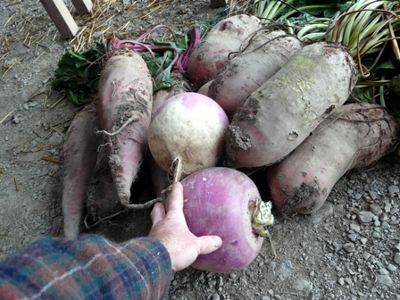February 14, 2012
Lindsay:
This morning I woke up to freezing rain falling on our not-yet-melted snow. The days are noticeably longer, the sun is warm (when it's out) and I have even heard the first of the frogs down by the creek. So spring is on its way, but it certainly isn't here yet.
But it's these winter days that make planning for the upcoming growing season, when the light is long and the air is warm, all the more enticing. So I thought I would share some of my musings on plans for the 2012 garden.
 A rockwall terrace in the garden similar to one we will build this season
A rockwall terrace in the garden similar to one we will build this season
Over the past few years, we have steadily been increasing our growing space for vegetables. On our land, this means first creating a terrace, so that it is some semblance of flat and the water that is so precious to the mid-August plants doesn't just run down hill. It also means adding a significant amount of soil amendments (created by the various animals) so that our clay rich soil is better aerated. This work is important to increase our capacity to feed ourselves. However as the father of ecology Barry Commoner espoused "everything is connected to everything else" which means you can't just change one thing.
Irrigation is critical in our dry summers, and so we can only increase our growing capacity so much before we have to also increase our irrigation capacity. At this point, what we need is more water storage tanks to house the water that we have in abundance in the winter and spring for the dry summer and early fall months. The best way that we have come up with to economically store some 100,000 gallons of water is ferro-cement tanks. Building a series of ferro-cement tanks, however, is not a trivial task. We have recently acquired some of the equipment necessary to move this work forward and so hopefully we will be in a position to do so in the near future. But in the mean time, it means focusing on producing food with our current irrigation capacity.
Another piece of the equation is labor. As we have been increasing our growing spaces for perennial and annuals alike, I have been steadily increasing the amount of plants we have growing on site. While this is necessary for our long-term resiliency, tending to the plants--all of them--is no small task. While with time, many of the perennials will be able to make it through the dry summer with far less attention, they are still young now with small root systems and so need to be nursed through the dry season. And this nursing just takes time.
 Mangel Beets from Wolf Tree Farm
Mangel Beets from Wolf Tree Farm
www.wolftreefarm.com
So my hope for this upcoming season is to some degree scale back the main garden and focus on the food producing plants, as opposed to the experimental crops. This means root crops (potatoes, parsnips, beets, turnips, rutabagas), brassicas (greens, cabbages and broccoli), squashes (winter and summer), a few precious tomatoes and eggplants, one variety of dry corn, beans and peas, and of course herbs.
I have also finally given in to the reality that successive planting here in the highland desert just doesn't make sense. It can be done if significant amount of water is given in July and August. However, for this season I am choosing to focus on one round of planting in the spring. Spring planted/seeded crops grow mostly off of already existing soil moisture, which means using less water and taking less time. With any luck, this scaling back will free my time up to focus more on the perennials and improving the irrigation systems, while also producing quite a bit of fresh food for the kitchen.
We are going to continue another season with the sugar beets--as they grew quite well--and I want to see more of what we can do. We are also going to try growing mangel beets, which are a great food crop for the animals, some growing up to 20lbs each! But the seeds are quite hard to find and only offered by rare seed companies. Mangel beets were once an integral part of the small farm, helping to feed the animals through winter, and that seed for them is so difficult to find is really quite unsettling. Yet another example of the loss of food biodiversity triggered by agribusiness and monocultures. So, I very much hope to be able to save seed next year (beets are a biennial and take 2 years to produce seed) from this endangered variety of beets.
I do want to still be expanding the growing space in the main garden. So we are planning on building another terrace, supported by a rock wall, on the southern end of the main garden. This terrace, however, won't be utilized this season.